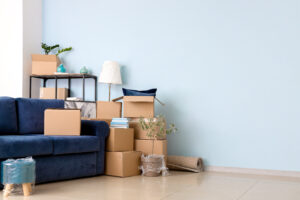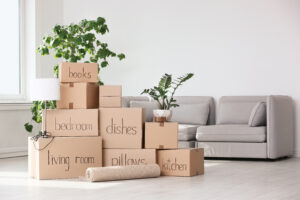Packing Tips for Moving from a Top Move Organizer

13 Jul 2023

Packing Tips for Moving from a Top Move Organizer.
Why Proper Packing Matters.
This time of year many people in our Boston area are moving.
Packing is more than just putting your belongings in boxes. It’s a crucial part of the moving process that can significantly impact the ease and efficiency of your move. Proper packing ensures that your items are protected during transit, reduces the risk of damage, and makes unpacking at your new home a breeze. Moreover, organized packing can save you time and stress, allowing you to focus on settling into your new space.
Pre-Packing Tips
Before you start packing, it’s essential to declutter your home. This step can make the packing process more manageable and prevent you from moving items you no longer need or use. Here’s how to do it:
Sort and Categorize Items
Start by going through each room in your house and categorizing items into four groups: keep, donate, sell, and discard. Be honest with yourself about what you really need and use. Items that haven’t been used in a year won’t be missed.
Decide What to Keep, Donate, or Discard
Once you’ve sorted your items, decide what to do with each category. Keep essential items, frequently used, or have sentimental value. Donate items that are still in good condition but no longer serve a purpose in your life. Sell items that are valuable but unnecessary. Discard items that are broken, damaged, or unusable.
Start Early
Don’t wait until the last minute to start packing. Begin the process a few weeks or even months in advance, depending on the size of your home and the amount of stuff you have. Starting early gives you ample time to sort, declutter, and pack comfortably.
Essential Packing Supplies
When packing for a move, having the right supplies can make all the difference. Here are some essential packing supplies you’ll need:
Boxes
You’ll need a variety of box sizes to accommodate different items. Small boxes are perfect for heavy items like books, while larger boxes are great for lighter, bulkier items like bedding and kitchenware. Specialty boxes, such as wardrobe boxes or dish pack boxes, can be used for clothing on hangers and fragile kitchen items.
Packing Paper and Bubble Wrap
Packing paper is essential for wrapping items and filling empty spaces in boxes. It provides protection and prevents items from moving around during transit. Bubble wrap provides extra protection for fragile items. It’s perfect for wrapping dishes, glassware, and other breakable items.
Packing Tape
Strong packing tape is necessary to secure your boxes. Make sure to get a tape dispenser for easy application. Having a couple of rolls of tape on hand is also a good idea, as you’ll likely use more than you expect.
Labels and Markers
Labels and markers are crucial for keeping your boxes organized. Clearly label each box with its contents and the room it belongs to. This will make unpacking much easier and more efficient. Consider using color-coded labels for each room to make it even easier to identify where each box should go in your new home.
Other Supplies
Other useful packing supplies include a box cutter (for opening boxes), stretch wrap (for securing drawers and doors on furniture), and furniture pads or moving blankets (for protecting furniture and large items).
Room-by-Room Packing Guide
Packing your home room by room can make the process more manageable and efficient. Here’s a detailed guide to help you:
Kitchen
The kitchen is often the most daunting room to pack due to the many items and their varying sizes and shapes. Start with items you rarely use, such as specialty cookware or holiday dishes. Pack dishes and glassware individually, using plenty of packing paper to prevent breakage. Pots and pans can be nested to save space. Remember to label each box clearly with its contents and the room it belongs to.
Living Room
The living room typically contains a mix of items, including books, electronics, decorative items, and furniture. Remove all items from shelves and cabinets and sort them into categories. Wrap fragile items in bubble wrap and pack them in small or medium boxes. Disassemble furniture if possible to save space and make transportation easier. Use moving blankets or furniture pads to protect furniture from scratches and dents.
Bedrooms
When packing bedrooms, start with off-season clothing and spare bedding. Use vacuum bags to save space and protect your items from dirt and moisture. Pack jewelry and small items in separate boxes to prevent them from getting lost. If you’re packing a child’s room, involve them and let them pack a box of their favorite toys.
Bathrooms
Bathrooms usually contain a lot of small items. Start by disposing of any expired or nearly empty products. Pack toiletries in sealable bags to prevent leaks. Towels and bath mats can be used as padding for other items.
Home Office
If you have a home office, start sorting and organizing your documents. Shred any unnecessary papers and pack important documents in a separate box that you can keep with you during the move. Pack books in small boxes to prevent them from becoming too heavy. Wrap electronics in bubble wrap and secure any loose cables with zip ties.
Special Packing Considerations
While packing may seem straightforward, certain items require special consideration to ensure they are transported safely and efficiently. Here’s a detailed guide on how to handle these special packing considerations:
Fragile Items
Fragile items such as glassware, ceramics, and artwork require extra care when packing. Wrap each item individually in bubble wrap, securing it with packing tape. Place these items in a box lined with crumpled packing paper for additional cushioning. Pack them tightly together to prevent movement, but avoid overpacking, which can lead to pressure and breakage. Fill any remaining space in the box with crumpled packing paper. Label the box as ‘fragile’ and ‘this side up’ to ensure proper handling.
Large or Awkward Items
Packing large or awkward items such as furniture, appliances, and musical instruments can be challenging. Disassemble furniture if possible, and secure all loose parts and screws. Wrap each piece in moving blankets or bubble wrap to protect against scratches and dents. For appliances, ensure they are clean and dry before packing. If you have the original packaging for any of these items, use it. If an item is particularly large or heavy, consider hiring professionals to ensure it’s packed and moved safely.
Valuable or Sentimental Items
Valuable or sentimental items such as jewelry, important documents, and family heirlooms should be packed separately. These items should be kept with you personally on moving day if possible. Use jewelry boxes or small containers for jewelry and small items. Important documents should be kept in a waterproof document holder. Pack larger sentimental items as you would fragile items, with plenty of padding and protection.
Efficient Packing Techniques
Packing efficiently can save you time, space, and stress during your move. Here are some techniques to help you pack like a pro:
Start Early and Pack in Stages
The earlier you start packing, the less stressful it will be. Begin with items you use less frequently, such as seasonal decorations or rarely used kitchen appliances. As your moving day approaches, you can start packing items you use more frequently. Packing in stages also allows you to sort through your belongings and decide what to keep, donate, or discard.
Use the Right Size Boxes
Using the right size boxes can make a big difference in your packing process. Small boxes are perfect for heavy items like books, as they can be heavy to lift when packed in larger boxes. Larger boxes are great for lighter, bulkier items like bedding or curtains. This makes the boxes easier to carry and reduces the risk of them breaking under weight.
Use Your Luggage
Suitcases and duffel bags are perfect for packing clothes, bedding, and towels. They are easy to transport and save you from buying extra boxes. They take up less space than boxes and can be easily stored in your new home.
Post-Packing Tips
Once you’ve finished packing, there are a few things you can do to make your move smoother:
Label Your Boxes
Clearly label each box with its contents and the room it belongs to. This will make unpacking much easier and more efficient. Consider using color-coded labels for each room to make it even easier to identify where each box should go in your new home.
Prepare an Essentials Box
Pack a box with items you’ll need immediately after your move, such as toiletries, a change of clothes, and basic kitchen items. This will save you from rummaging through boxes to find what you need on your first night.
Clean Your Home
Once all your items are packed and out of the way, take the time to clean your home. This is especially important if you’re selling your home or moving out of a rental property. It’s also a nice gesture for the new occupants.
Hiring Professional Organizers for Moving
If packing and moving feel overwhelming, consider hiring professional organizers like us at Organizing Boston. Our team is professionally trained in-home organizing, office organizing, and move management. We can help you declutter, pack, and set up organizing systems in your new home. We work efficiently and non-judgmentally and can handle the entire organizing process or focus on the areas where you need the most help.
Making Your Move Smooth and Organized with Professional Help
Moving doesn’t have to be a stressful process. With efficient packing techniques, post-packing tips, and the help of professional organizers, you can make your move smooth and organized. At Organizing Boston, we are dedicated to providing our clients with an exceptional organizing experience in a judgment-free atmosphere resulting in a comfortable, functional, and orderly personal space.



